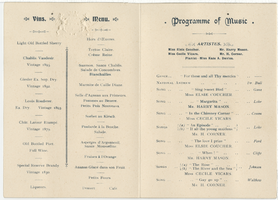Search the Special Collections and Archives Portal
Search Results

Interview with Wayne Albert Violette, January 12, 2005
Date
Archival Collection
Description
Text
Paul Sarno oral history interview
Identifier
Abstract
Oral history interview with Paul Sarno conducted by David G. Schwartz on July 13, 2007 for the Remembering Jay Sarno Oral History Project. Sarno begins by discussing the Sarno family, his grandparents, their Jewish heritage, and the early life of his uncle, Jay Sarno, and his father. Sarno then describes how his uncle married a lot later than his older siblings and he was the only one who had personal hobbies such as golf. Sarno then chronicles his uncle’s role as a businessman in Las Vegas, Nevada and how he only visited Las Vegas once because his father was a gambling addict. Lastly, Sarno discusses everything he knew about his uncle’s relationship with Allen Dorfman, the Teamster’s Union, and his legal troubles with the Internal Revenue Service.
Archival Collection
UNLV Libraries Collection of Grand Casinos, Inc. Promotional Materials and Reports
Identifier
Abstract
The UNLV Libraries Collection of Grand Casinos, Inc. Promotional Materials and Reports includes annual reports, financial reports, newspaper and magazine clippings, press kits, press releases, and promotional materials for Grand Casinos, Inc. properties in Mississippi, Louisiana, Minnesota, and Nevada, dating from 1992-2002.
Archival Collection

Film transparency of the ruins of the H. D. and L. D. Porter Brothers Store, Rhyolite, Nevada, November 25, 1948
Date
Archival Collection
Description
Image
Jackson, Jerry
Born January 14, 1936 in Tulsa, Oklahoma, Jerry Reese Jackson has worked as a show producer, director, costume designer, choreographer, lyricist, and composer. In Las Vegas, Nevada, Jackson is best known for his work on the Folies-Bergère at the Tropicana Hotel and Casino where he served as artistic director, choreographer, and later as costume designer for nearly thirty-five years, beginning in 1975 and ending with the show's closure in 2009.
Person

Film strip of individuals or Hoover Dam construction, image 003: photographic print
Date
Archival Collection
Description
Image

Film strip of individuals or Hoover Dam construction, image 005: photographic print
Date
Archival Collection
Description
Image

Film strip of individuals or Hoover Dam construction, image 008: photographic print
Date
Archival Collection
Description
Image

